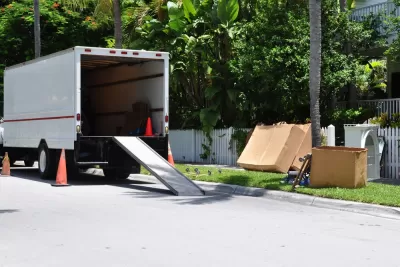Staying in place is more and more the norm, even among historically mobile young people.

If U.S. migration trends are any indicator, we're living in a less-mobile, less-dynamic age. "For the first time since the Census Bureau began recording annual migration statistics, fewer than 10% of Americans changed residence in a single year, according to just-released data for 2018-19," William H. Frey writes.
Basing his discussion on the Census Bureau's newly-released data on geographic mobility, Frey notes that migration trends show a "fairly consistent decline since the late 1940s to 1960s period, when roughly one-fifth of Americans changed residence annually." As one might expect, the Great Recession further exacerbated that trend. But migration hasn't surged back up with the economy.
"Especially noteworthy," Frey says, "are the migration declines for the nation's young adult population, now mostly occupied by millennials." Usually the population's most mobile segment, young adults aged 18-34 are increasingly staying put due to high housing costs, underemployment, and related factors.
Frey notes that low migration may still be an aftereffect of the recession, in which case "mobility might rise somewhat for millennials and their Gen Z counterparts as the economy continues to prosper. Yet even so, these downward migration trends suggest a future of somewhat less demographic dynamism, cutting off people and places from broader economic changes and opportunities nationwide."
FULL STORY: For the first time on record, fewer than 10% of Americans moved in a year

Maui's Vacation Rental Debate Turns Ugly
Verbal attacks, misinformation campaigns and fistfights plague a high-stakes debate to convert thousands of vacation rentals into long-term housing.

Planetizen Federal Action Tracker
A weekly monitor of how Trump’s orders and actions are impacting planners and planning in America.

In Urban Planning, AI Prompting Could be the New Design Thinking
Creativity has long been key to great urban design. What if we see AI as our new creative partner?

King County Supportive Housing Program Offers Hope for Unhoused Residents
The county is taking a ‘Housing First’ approach that prioritizes getting people into housing, then offering wraparound supportive services.

Researchers Use AI to Get Clearer Picture of US Housing
Analysts are using artificial intelligence to supercharge their research by allowing them to comb through data faster. Though these AI tools can be error prone, they save time and housing researchers are optimistic about the future.

Making Shared Micromobility More Inclusive
Cities and shared mobility system operators can do more to include people with disabilities in planning and operations, per a new report.
Urban Design for Planners 1: Software Tools
This six-course series explores essential urban design concepts using open source software and equips planners with the tools they need to participate fully in the urban design process.
Planning for Universal Design
Learn the tools for implementing Universal Design in planning regulations.
planning NEXT
Appalachian Highlands Housing Partners
Mpact (founded as Rail~Volution)
City of Camden Redevelopment Agency
City of Astoria
City of Portland
City of Laramie





























